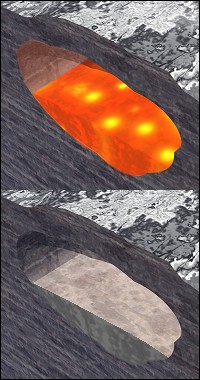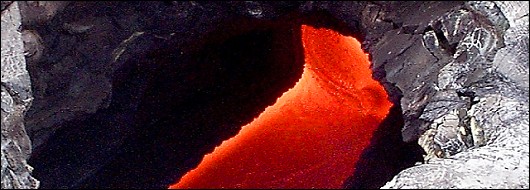Geologic Setting
Lavatubes of the Mount St. Helens Region
Geological SettingLavatubesApe CaveCave Basalt MapCave ClimateVideo Clips
Lavatubes
 Numerous surficial features of basaltic lavaflows contribute to the formation of tubes (Hyde and Greeley, 1973; Foxworthy and Hill, 1982; Pringle, 1993). For example, exsolvation of gases from lava and hydrostatic pressure both combined with lava overflow from breaks in the surface crust, produce ridges along lavatubes. Large mounds known as tumuli may be hollow or solid and can be as large as 50 m in diameter and a couple of meters high. When the tumulli are hollow, they are often very thin-walled. When the active eruption period ceases and the lava drains out of the tube, they are vulnerable to collapse leaving what appear to be craters with raised rims.
Numerous surficial features of basaltic lavaflows contribute to the formation of tubes (Hyde and Greeley, 1973; Foxworthy and Hill, 1982; Pringle, 1993). For example, exsolvation of gases from lava and hydrostatic pressure both combined with lava overflow from breaks in the surface crust, produce ridges along lavatubes. Large mounds known as tumuli may be hollow or solid and can be as large as 50 m in diameter and a couple of meters high. When the tumulli are hollow, they are often very thin-walled. When the active eruption period ceases and the lava drains out of the tube, they are vulnerable to collapse leaving what appear to be craters with raised rims.
Hyde and Greeley (1973) discuss a detailed survey of 9,125 m of lava tubes and point out a number of potential correlations between the lavatubes and various surface features. They conclude that most tubes form from shear planes in lava in a laminar flow regime, that is, they are intrinsic to the rheology of the flow itself. However, as we have seen in many active more recent Hawaiian lava flows, often an open lava rille gives rise to a tube by the freezing out from spattering of lava by turbulent flow freezes out and sticks to the edges of rilles and roofs them over.
Clearly, flowing lava responds to both pre-existing channels and also to the general topography of the underlying surface. Flows typically erode the material over which they travel. Often a tube represents the thickest parts or flows because they flow through channels that extend below grade of the original surface.
Semitrench tubes result from a lava flow through an already existing channel. This type of flow builds up successive crustal walls. Eventually such a channel may roof over if the flows persist for a long enough time. The width of these is dependent upon the original width of the channel, but the length depends upon the usual factors of lava fluidity and gravity. True trench tubes form by a process of fluid lava erosion that cuts a channel just as water or ice will do. The subsurface positioning of these tubes can be quite deep. The primary material of the cave is the parent rock lined with a variable coating of lava.
Tubes frequently collapse at least partially after they cease to receive new lava. As the rock cools and shrinks, cracks form which can lead to immediate collapse or provide pathways for subsequent weathering by water and freezing. Complex multiple tube systems can form by the layering of new tubes over old with each subsequent eruption.
At Mount St. Helens, the large amount of ash and pumice produced provides a ready source to liberally coat the floors of tubes with sand. This material is washed and blown into the cave over time. Most of the sand deposits are thought to be from a particularly notable 450 year old eruptive sequence of four episodes named the Early Kalama Period. The 1980 eruptions produced voluminous ash and heavy rains and snow melt that were both a consequence of the eruption event washed fresh ash from the upper slopes onto the Cave Basalt Flow once again. This new material can be seen in several caves, where sand and gravel cover the floor surfaces. The material in Hopeless Cave, a small lava tube up slope from Ape cave, was completely filled by this material.
Several caves will be visited during this trip, however, we only describe Ape Cave in detail here. Table 1 provides a summary of important physical characteristics of all of the lavatube caves in the region.


